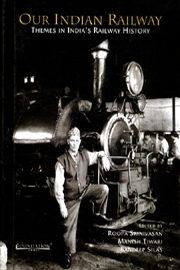Book contents
- Frontmatter
- Contents
- Foreword
- Preface
- Introduction
- 1 The Colonial Context of the Bengal Renaissance: A Note on Early Railway–Thinking in Bengal
- 2 Minute by Dalhousie on Introduction of Railways in India, as Submitted to the Court of Directors, 4 July 1850
- 3 Ackworth Committee Report
- 4 Competition and Adaptation: The Operation of Railways in Northern India: Uttar Pradesh 1860–1914
- 5 Economic Nationalism and the Railway Debate, circa 1880-1905
- 6 Railway Policing and Security in Colonial India, c. 1860–1930
- 7 Indian Nationalism and Railways
- 8 The Railway in Colonial India: Between Ideas and Impacts
- 9 The Dark Side of the Force: Mistakes, Mismanagement and the Malfeasance in Early Railways of the British Indian Empire
- 10 Tunnels and Bridges: Railways, Narrative and Power in two Novels of India
- 11 A View of the History of Indian Railways
- 12 The Romance of Steam
- Index
- Plate section
8 - The Railway in Colonial India: Between Ideas and Impacts
Published online by Cambridge University Press: 26 October 2011
- Frontmatter
- Contents
- Foreword
- Preface
- Introduction
- 1 The Colonial Context of the Bengal Renaissance: A Note on Early Railway–Thinking in Bengal
- 2 Minute by Dalhousie on Introduction of Railways in India, as Submitted to the Court of Directors, 4 July 1850
- 3 Ackworth Committee Report
- 4 Competition and Adaptation: The Operation of Railways in Northern India: Uttar Pradesh 1860–1914
- 5 Economic Nationalism and the Railway Debate, circa 1880-1905
- 6 Railway Policing and Security in Colonial India, c. 1860–1930
- 7 Indian Nationalism and Railways
- 8 The Railway in Colonial India: Between Ideas and Impacts
- 9 The Dark Side of the Force: Mistakes, Mismanagement and the Malfeasance in Early Railways of the British Indian Empire
- 10 Tunnels and Bridges: Railways, Narrative and Power in two Novels of India
- 11 A View of the History of Indian Railways
- 12 The Romance of Steam
- Index
- Plate section
Summary
The idea of establishing and expanding a railway system in India offered the most vibrant excitement in colonial mind. This excitement was reflected in the thoughts of two categories of people: those who had a romantic vision of India, often diluted by ingredients of ‘civilizing mission’ and those who found India as a veritable home for capitalist initiatives. The issues of capital investment and its impact on India's macroeconomic performance have been explored to a great extent. The issue of civilizing mission has also recently been subjected to close scrutiny. However, the ‘discussions’ and debates about the above two themes have considered the idea of cultural superiority of the West and Western capitalism as omnipotent. There has been hardly any focus on how the civilizing mission or the patterns of capitalist development in relation to the railway was informed by local circumstances. The lack of appreciation of the forces within both Indian society and nature has also led to complete indifference to the impact of railways on the indigenous society and physical landscape. This article focuses on how the railway projects in India were informed by and negotiated within Indian social and ecological atmosphere. The particular focus would be on the Bengal Delta.
In cultural discourse level, the railway as a tool for civilizing mission could best be explained in terms of nineteenth-century romanticism. Lord Tennyson had a vision of taking some ‘savage women’ and of raising his ‘dusky race’ in some distant parts of the world. In his project, he, however, was not handicapped by the obstacles of distance and sluggishness as the pre-railway generation of the messengers of civilizing mission had experienced.
- Type
- Chapter
- Information
- Our Indian RailwayThemes in India's Railway History, pp. 173 - 186Publisher: Foundation BooksPrint publication year: 2006
- 2
- Cited by



